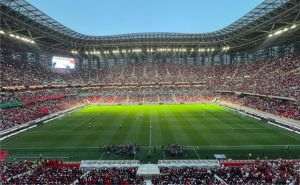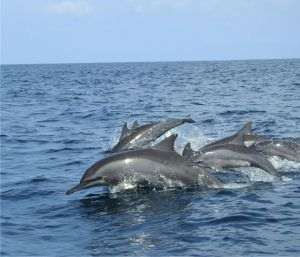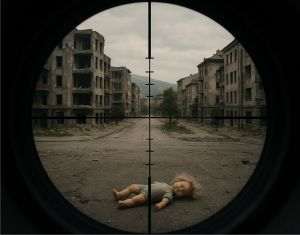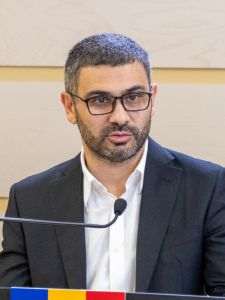As every year, in the city of Konya, in the region of the same name, the month of September concluded with the International Mystic Music Festival, organized by the Ministry of Culture and Tourism. This year, the event expanded to 16 cities, featuring more than 6,000 cultural activities, with the participation of around 40,000 artists, taking place in over 600 locations across Adana, Şanliurfa, Bursa, Samsun, Trabzon, Van, Cappadocia, Erzurum, Canakkale, Gaziantep, Konya, Ankara, Istanbul, Diyarbakir, İzmir, and Antalya.
Since September 21, the International Mystic Music Festival in Konya has been offering unique experiences for both residents and visitors, presenting cultural events ranging from concerts and exhibitions to theater performances. The event takes place every year in the center of the mystical city, next to the tomb of the wise Mevlana Rumi. The Konya Festival always culminates on September 30, Rumi's birthday, as it commemorates the great sage in the best possible way, in accordance with his boundless love and complete trust in humanity.
Born in a small village in Persia and settling in Konya after the Mongol invasion, Rumi concluded that God is one, regardless of how He is named in the beliefs of different peoples. Mevlana Rumi preached love for faith, asserting that "all religions speak of love, but love has no religion."
The connection between the faithful and the Divine was realized through a mystical dance. They wore long, flowing white robes, had their heads covered with turbans, and sometimes wore black cloaks as well. To the rhythm of penetrating music, which could even be described as hypnotic, they spun until they reached a state of ecstasy, claiming that this way they attain supreme spirituality. The whirling dance is performed by dervishes and is part of an official ceremony known as Sama. Dervishes were often attributed the ability to perform miracles, said to possess supernatural powers.
Last week, I had the opportunity to attend several events at the International Mystic Music Festival in Konya, to listen to religious music, to see the dervishes spinning, to admire the welcoming people of the area, to enjoy the tranquility and impeccable cleanliness throughout the city, to feel the faith of the locals and tourists, and the desire of all for peace in the world.

I had the honor and pleasure of exchanging a few words and taking a photo with Esin Celebi, the last descendant of Mevlana Rumi, from the 22nd generation - a distinguished lady with an angelic face, a gentle gaze, and a soft voice, who told us that, for her, the festival means "to be together with everyone," considering this annual event a great experience for young people to listen together to different music from various countries and religions.
• Konya - a mix of history, art and mysticism
Located in the heart of Anatolia, Konya is the largest province in Turkey by geographic area (38,873 square kilometers), with a population of 2.3 million, of which 1.4 million live in the city of the same name. By population size, Konya is the seventh most populated city in the country. Known as the holy city of Mevlana and the whirling dervishes, Konya is a historic settlement with evidence of habitation dating back to prehistoric times.

It is said that this place was home to the first city on earth, built after Noah survived the flood and anchored his ark on Mount Ararat. Moreover, Konya is the magical land in the heart of Anatolia where the sacred fire of love of the sage Mevlana Rumi still burns.

In addition to its mosques, museums, cultural centers, stories, and religion, you will also fall in love with the culinary art in Konya. Here, you must come prepared to eat well, to taste various gastronomic delicacies made from lamb, beef, or chicken seasoned with salads and all kinds of spices, to savor incredible baklava and halva, and to not forget the fabulous ayran along with the indispensable Turkish teas and coffees. The small, colorful terraces, the souvenir shops in the city center and beyond, the local people, and the good prices complete the puzzle called Konya.
Thus, filled with ancient sites, unique beauties, and unforgettable destinations, offering adventures and memorable experiences, unique flavors, and magical landscapes, with monasteries, churches, mosques, mansions, chapels carved into rock with frescoes, and natural wonders whose origins date back to the Neolithic era, Konya is one of the Turkish regions that should not be missed.
• The Mevlana Mausoleum - the spiritual magnet of Konya
The most important attraction in Konya is the Mevlana Mausoleum, one of the largest museums in the country and the second most visited after the Topkapi Palace in Istanbul.

In the center of Konya, where once stood Mevlana's monastery, now lies the Mevlana Museum, which includes the mosque of the same name and the mausoleum, featuring an impressive turquoise dome that houses the tomb of Mevlana Rumi and those of his family members.
The Seljuk Sultan Kayqubad I invited Mevlana to Konya, where he offered him a rose garden to bury his father. When Mevlana died on December 17, 1273, he was buried in a sarcophagus alongside his father. In 1274, Husamettin Celebi, his successor in leading the Mevlevi Islamic order, ordered the construction of a mausoleum over his master's grave. Over time, due to the influence of the Mevlevi order, several buildings were added to the mausoleum, including a mosque and a cemetery. In 1926, the Mevlevi order was outlawed, and the mausoleum became a museum.

The most important features of the museum are located in the Tombs Hall, which houses nearly 70 sarcophagi, including the sarcophagus of Mevlana, located under the green dome, along with those of his father and closest acquaintances. The museum also displays a collection of traditional Turkish musical instruments, several ancient copies of the Quran, and poetry books by Mevlana, a collection of prayer rugs, and the spectacular dance of the whirling dervishes. However, the most important exhibit is a beautifully decorated box made of mother-of-pearl that contains a few hairs from the beard of the Prophet Muhammad. The mausoleum is a symbol of Turkey and appears on the 5000 lira banknote from 1981 to 1994.
In the museum courtyard, there are also exhibition halls featuring clothing items, writing instruments, notebooks with calligraphic writings, etc., and in the center is a fountain where those entering to pray can wash beforehand, according to ritual. Also in the courtyard, near the mausoleum, are several sarcophagi of other prominent figures from the Ottoman Empire's past, such as that of Sinan Pasha, along with a kitchen displaying life-sized figurines of people engaged in various activities of the time.
• The legendary story of the Church of Saint Helena
Also in Konya, in the village of Sille, lies the first Christian church in the world built for this purpose, Saint Helena, which represents one of the most famous architectural structures in the city.

In the year 327, Helena, the mother of the Eastern Roman Emperor Constantine, stopped in Konya on her way to Jerusalem for a pilgrimage. She saw the rock-carved temples from the early Christian eras in Sille and decided to build a new one for Christians here.
The building has undergone several restorations over time and now stands as a testament to the historical periods it has traversed. Sille, located about 15 kilometers from the center of Konya, holds special significance for Anatolian civilizations and is also an important site from the early Christian period. It is a unique town with a distinct way of life, characterized by its natural setting, architecture, customs and traditions, as well as impressive vineyards and gardens.
• Catalhoyuk - The First Proven Human Settlement
Konya, the place where the first known settlement, the first urbanization, and the first domestication of animals in the world took place, has been home to various civilizations in Çatalhöyuk-one of the Neolithic sites on the UNESCO World Heritage List. Thus, it is said that the first proven human settlement was Catalhoyuk. This settlement was built between 1800 and 1700 B.C.

At that time, without streets, the houses were joined together, equipped with doors connecting them, and people would go out onto the flat roofs to conduct their daily activities. Çatalhöyuk is located in Konya, approximately 140 km from Mount Hasan. Once there, tourists can visit two types of homes reconstructed from the originals and can see a part of the archaeological site of the Çatalhöyuk settlement. Before reaching the site, there is a museum that explains elements of the life and activities of the inhabitants of that time. One interesting piece of information relates to the remains of the deceased, which were buried beneath the place where they had slept during their lives.
• Panorama Konya Museum - 800 years of history in a few images
Among the must-see cultural attractions in the area is the Panorama Konya Museum, where we can discover the twists and turns of the past of the people of Konya, the traditions of the locals, and the culture of the place, all presented through impressive frescoes and paintings, life-sized figurines, ancient scenes, and miniature models representing various buildings, mosques, and institutions from Konya.

More specifically, the Panorama Konya Museum, one of the largest panoramic museums in Turkey, showcases the social life of the city of Konya in the 13th century and Mevlevi culture. The complex, built in the traditional style of Turkish Islamic art, is located approximately 500 meters from the Mevlana Museum in the Karatay district of Konya. This panoramic museum, the second of its kind in Turkey, offers a 360-degree view under an impressive dome. The main purpose of the museum is to introduce visitors to the universe of Mevlana Rumi and to explain the influence he and his family had on the city of Konya during that time. Among the most striking elements of the museum are the extremely realistic human statues made of silicone. These sculptures, along with other sketches, models, and figures, are displayed in a space covering a total area of 4,460 square meters. Opened in 2017, the museum provides a perspective on 800 years of history, using hyper-reality techniques to recreate that period as faithfully as possible.
• Semsi Tebrizi Mosque - a religious landmark for muslims

Among the tourist and spiritual attractions in Konya is the Semsi Tebrizi Mosque, named after the monk Mehmet Semsedi Tebrizi, a dervish who traveled to Konya. In 1244, he met Rumi, and they became spiritual friends. For Rumi, Semsi represented the spiritual light guiding him toward union with the divine. It is said that Mevlana Rumi stopped preaching at the theological school to spend more time with Semsi. Fearing they had lost their spiritual leader, Rumi's followers killed the monk Semsi, plunging Mevlana Rumi into despair. Thus, he took refuge in prayer and meditation and eventually laid the foundations of the Mevlevi Order (the Order of the Whirling Dervishes).
It is said that the tomb of Tebrizi is located within the Semsi Tebrizi Mosque, although there is no architectural evidence to support this. In any case, the mosque holds a special significance for Muslims.
• Large interactive Science Center

The Science Center in Konya is the first large-scale interactive center of its kind dedicated to informal learning about science and technology, created in cooperation with the Scientific and Technological Research Council of Turkey. Covering an interior area of about 26,000 square meters (with a total area of 100,000 square meters), the Center was first opened in April 2014 and includes exhibitions, models, robotics, an impressive planetarium, educational departments, and an astronomical observatory. Since its opening, the Center has welcomed over 500,000 visitors, and it is estimated that it will attract one million visitors annually, serving as both an educational space and an attractive destination for science enthusiasts.
• Journey through historical Konya at the TaşBina Cultural Center

The TaşBina Cultural Center is a cultural hub in Konya that takes you back in time and guides you through the history, literature, agriculture, and local life of the region with the help of technology. It features six rooms designed as a digital promotion center. Through interactive touch screens, panoramas, videos of characters performing various activities, etc., the historical periods of Konya are described. Additionally, a digital platform explains the developments in agriculture, industry, commerce, and tourism in the area. The cultural mosaic hall is spectacular, created by complementing mirrors and digital screens displaying symbols of the civilizations established in Konya, all integrated with mystical music. The gastronomy and crafts of Konya are also showcased on digital screens, and literal doors open to historical periods behind which images of works from those eras are projected.
• The spectacle of nature at the Tropical Butterfly Garden

The Tropical Butterfly Garden is one of the must-visit attractions in Konya for anyone in the area. Thousands of butterflies of various sizes and colors fly incessantly, seemingly inviting you to join their playful dance, swiftly approaching you before darting away, clinging to visitors' clothes as if pleading to frolic among the thousands of tropical plants.
Located in the Selçuklu district, the Tropical Butterfly Garden in Konya opened in the summer of 2015. The building, designed in the shape of a butterfly and covered in glass, won the award for Best Architectural Design in Turkey in the Public Buildings category at the 2018 Sign of the City competition. The structure covers an area of 7,600 square meters, including 3,500 square meters of walking paths. It is the first butterfly sanctuary in the country, featuring a butterfly flight area of 1,200 square meters. The environment provides a habitat for over 20,000 tropical plants from more than 150 species and thousands of tropical butterflies from habitats of tropical forests, belonging to up to 45 species. Here, the entire life cycle of butterflies can be observed, from caterpillar larva to adult stage. The garden also includes a Butterfly Museum, an Insect Museum, and a Nature Education Hall.

Many visits to Konya are part of various tourist circuits, as noted by Nedim Ozesmer, a tour guide at the Turkish Ministry of Tourism agency. Nedim Ozesmer stated: "Konya is a large city, a business center in Anatolia. We have routes that start in Istanbul, Izmir, and Antalya on the Aegean Coast, which go to Cappadocia, and all pass through Konya because it is a very important center for Muslims. Therefore, tourists come to Turkey not only for Konya but often spend one night in Konya or just come to visit the Mevlana Mausoleum and then head to Cappadocia."
According to the tour guide, the hotels in Konya are generally high-level, 4-5 star establishments, as most visitors come for business. "Tourists come from all over the world-especially from China or other Asian countries (Hong Kong, Taiwan, Indonesia, Malaysia). During the pandemic, many Romanians were coming to Turkey, even though tourists from other countries were not visiting. Tourism numbers have not yet reached pre-pandemic levels, but the industry is recovering."
Nedim Ozesmer also mentioned that wars have not influenced tourism in Turkey. According to data provided by the agency, last year Turkey welcomed over 49.2 million foreign tourists, an increase from 2022, when the country recorded 44.5 million foreign tourists. In the first seven months of the current year, nearly 29 million foreign tourists visited Turkey.






































































